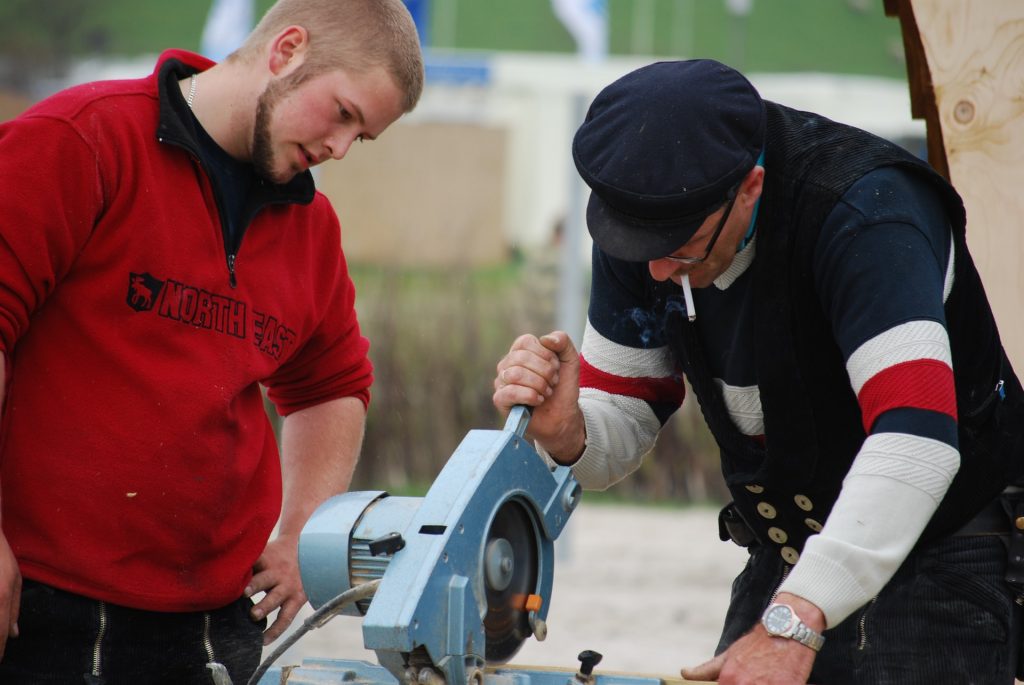If you’ve got an old circular saw blade lying around that you don’t really use anymore, you can try to turn it into a knife.
It’s a great project to take on when you have some time to kill. You’ll turn an old piece of equipment that you don’t use much into something new and useful.
Quick Summary
In this post, we will discuss how you can manufacture a knife from a circular saw’s blade.
We will go over all the tools and supplies you will need for this project as well.
So without further ado, let’s get into it.
Tools and Supplies Needed
Before you actually do anything, it’s a good idea to take some time and gather all the tools and supplies needed for the job.
This is a fairly lengthy and complex job so you will need a fair amount of tools to get it done properly.
Hence, always grab everything you need first and have it on hand.
That way, you won’t have to halt the process and go look for a tool every time you reach the next step.
The tools and supplies you will need are:
- An angle grinder
- Files
- A bench vice
- Sandpaper
- A Bench grinder (optional)
- A drill
- A saw that can cut small pieces of wood
- A propane or MAPP torch
- A hacksaw (optional)
- 10″ circular saw blade or any other source of steel
- Bricks
- A small piece of hardwood
- A brass rod
- A marker
How to Make a Knife from a Circular Saw Blade (Step-by-Step Guide)

Please note that before getting started, you should wear all the relevant safety equipment such as eye protection, hand protection as well as a mask for breathing.
Follow the steps below to manufacture your knife:
Step 1: First of all, take your circular saw blade and make a line on it with your marker.
This line will indicate where you need to cut the circular saw blade.
Step 2: Clamp the circular saw blade down securely and use your angle grinder with a cutoff wheel to cut the blade.
Make sure you don’t twist or apply too much pressure to the grinder while cutting. Cutoff wheels are known to explode if you don’t use them correctly.
Just be patient and let your angle grinder do the work.
Step 3: You can make an outline of the knife on the blade using a marker and then start to make relief cuts with your grinder.
Use a file for finer details and complex, curved cuts. For everything else, use the angle grinder.
Step 4: Next, you need to grind the bevel for your knife.
To have a knife with its edge centered and its sides to be even, you want to make these adjustments with a file and a jig.
This will be a lot less efficient but it will result in a knife that is well-balanced.
However, if you want to be cheap and quick with it, then you can definitely use your angle grinder for this job with a flap disc.
This results in a lower-quality knife but it gets the job done.
In the end, you must decide how good of a knife you want out of the circular saw blade and then use the tools accordingly.
Step 5: Next, you have to get the knife hot in order to harden the steel.
You can do this with a torch and some bricks which will contain the heat being emitted from the torch. If you can get fire bricks, that’s ideal. However, if you can’t, you can just use regular bricks. They still work, just not as well.
Bring the temperature of the steel up until it no longer attracts a magnet. Once it reaches that stage, quench it in oil. You can use a variety of oils for this job such as used motor oil, clean motor oil, vegetable oil, etc.
Next, leave the knife in a 400-degree oven for 4 hours to allow it to temper the steel. After 4 hours, turn the oven off and let the knife reach room temperature on its own.
Step 6: Now that the steel has been tempered, it’s time to put a handle on the knife.
You can use any type of hardwood for the handle.
Drill a couple of holes on the handle part of your knife. Make sure that the edges are in line with each other as well as the spine of the blade. The spine is the back edge of the knife.
Drill similar holes in the wood that you intend to make the handle.
You will need to use pins to connect the handle to the blade. Any type of pins will do as long as they’re dull. We used a ⅛ inch brass rod.
Attach the handle to the knife with epoxy or super glue. Next, insert your pins and bend them over on the other side with a hammer so that they can’t come out.
For shaping, you can use your angle grinder or an orbit sander.
Step 7: Next, use sandpaper of varying grits to polish the blade of your knife.
One thing you can do is to firmly attach a piece of sandpaper to your workbench using glue or something similar. Then, you can rub your knife on it in order to polish the blade.
This will remove any particles, scratches, or imperfections from the blade that it may have gotten from previous jobs.
Of course, you don’t need to do this step if you’re using a new circular saw blade.
Step 8: The concepts of sharpening a knife are out of the scope of this post.
However, the general idea is to use a coarse stone and then gently move up to a fine one. In the end, you want a nice edge on your knife.
Have some patience during sharpening. It will be rewarded.
Wrapping Things Up…
This brings us to the conclusion of our post on how to make a knife from a circular saw blade.
As you can see, you can definitely make something beautiful and useful out of an old saw blade. Once a circular saw blade reaches the end of its life, don’t throw it away; Make a knife out of it.
If you have any questions about the process, please feel free to ask us in the comments section below.
Check out Tools Advisor Pro for more DIY.

